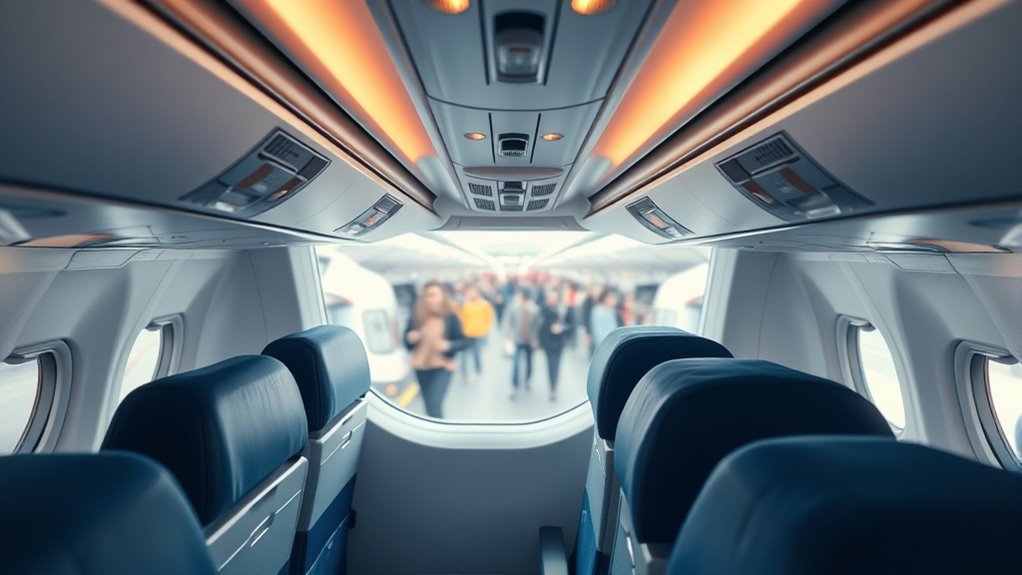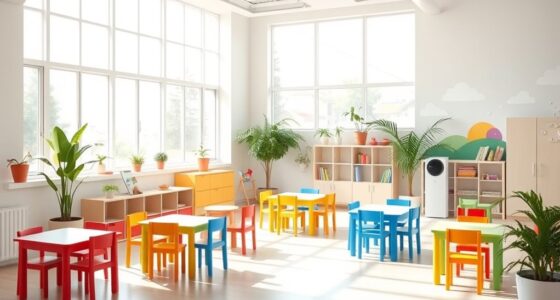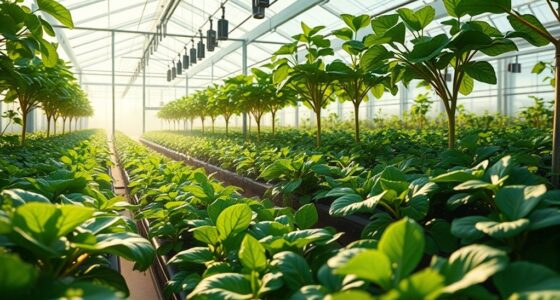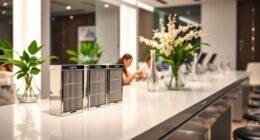Aircraft cabins and transportation hubs use advanced ventilation and filtration systems to keep the air fresh and safe. These systems constantly circulate outside air, filter out pollutants, bacteria, and viruses with HEPA filters, and refresh cabin air every few minutes. They control humidity and airflow to prevent dehydration and discomfort. Because of these measures, your environment stays clean and healthy during your journey. Keep going, and you’ll discover more about how these systems protect your well-being.
Key Takeaways
- Modern aircraft cabins use advanced ventilation and HEPA filtration to ensure high air quality and remove airborne pollutants and pathogens.
- Air circulation systems maintain fresh, conditioned air every 2 to 3 minutes, reducing the buildup of harmful substances.
- Cabin humidity levels are controlled between 20-30%, preventing dehydration and skin dryness during flights.
- Transportation hubs utilize ventilation systems with filtration to improve air quality and reduce airborne disease transmission.
- Proper environmental controls in both aircraft and hubs promote passenger health, safety, and overall comfort.

Have you ever wondered what the air inside an airplane cabin is really like? The truth is, the quality of this air plays a pivotal role in your comfort and health during travel. Modern airplanes are equipped with advanced ventilation systems designed to guarantee the air remains fresh and safe. These systems constantly circulate and refresh the cabin air, filtering out pollutants, bacteria, and viruses. They work by drawing in outside air, which is then conditioned and distributed throughout the cabin, mixing with recirculated air that has been filtered multiple times. This continuous process helps maintain a controlled environment, reducing the buildup of harmful substances and minimizing the risk of airborne illnesses. As a passenger, you might not see these systems in action, but they’re essential in safeguarding your passenger health. Additionally, the design of these systems incorporates principles of air quality management, ensuring optimal conditions for travelers.
The ventilation systems in aircraft are engineered to deliver a consistent flow of clean air, typically replacing the entire cabin air every two to three minutes. This rapid exchange is indispensable because it prevents the accumulation of carbon dioxide and other contaminants that can lead to discomfort or health issues. The HEPA filters used are incredibly effective, capable of capturing over 99.9% of airborne particles, including bacteria and viruses. This means that the air you breathe in during a flight is substantially cleaner than what you might encounter in some enclosed environments on the ground. The design of these systems also ensures that the airflow is directed from the ceiling to the floor, reducing the likelihood of turbulence or drafts that could disturb passengers. All of these features work together to create a healthier environment, especially important given the close proximity of travelers in an enclosed space.
Passenger health is directly impacted by the quality of the air they breathe onboard. Poor air quality can lead to discomfort, dehydration, headaches, or even respiratory issues, especially during long flights. That’s why airlines invest heavily in maintaining excellent ventilation systems. These systems are also essential in controlling humidity levels, which typically hover around 20-30%. Low humidity can cause dehydration and dry skin, making it even more important for the ventilation to maintain a balanced environment. Additionally, good ventilation reduces the spread of airborne pathogens, creating a safer space for everyone. Ultimately, the combination of sophisticated ventilation systems and diligent maintenance ensures that your journey is not only comfortable but also as safe as possible regarding air quality and passenger health, giving you peace of mind as you travel through the skies.
Frequently Asked Questions
How Do Aircraft Cabin Air Filters Compare to Home HVAC Filters?
You’ll find that aircraft cabin air filters generally have higher air filter efficiency compared to home HVAC filters, thanks to advanced filtration technology. These filters are designed to remove tiny particles, bacteria, and viruses, ensuring cleaner air during your flight. In contrast, home filters focus more on allergen removal and air quality for larger spaces. So, fundamentally, aircraft filters are more specialized for high-performance air purification.
Are There Specific Times During a Flight When Air Quality Worsens?
During a flight, cabin air fluctuations can make it feel like you’re riding a rollercoaster. You might notice in-flight pollution peaks during takeoff and landing, when engines power up or slow down, stirring the air. These moments can cause temporary dips in air quality, but modern aircraft are equipped with high-efficiency filters that continuously clean the air. Staying hydrated and avoiding heavy perfumes can help you breathe easier during these fluctuating times.
What Are the Long-Term Health Effects of Exposure to Cabin Air?
Exposure to cabin air over the long term can lead to health issues like chronic respiratory problems and weakened immune system. You might experience persistent coughs, breathing difficulties, or increased susceptibility to infections. Continuous exposure could also cause headaches or fatigue. To protect yourself, consider using masks or air purifiers when possible, and stay informed about cabin air quality. Regular health check-ups are essential for early detection of any issues.
How Do Different Aircraft Models Vary in Air Filtration Systems?
While some aircraft models prioritize advanced air filtration, others rely more on engine ventilation, making their air quality vary markedly. You’ll find that newer planes often feature HEPA filters, capturing tiny particles and bacteria, whereas older models may depend on basic ventilation systems. This difference affects the overall air freshness and safety, so as a traveler, understanding these variations helps you make informed choices about your comfort and well-being during flights.
Can Passengers Do Anything to Improve Their Personal Air Quality Onboard?
You can improve your personal air quality onboard by using personal air purifiers, which help filter out airborne particles. Choose your seat strategically—preferably near the front or away from bathrooms and galley areas where air circulation may be lower. Keep your mask handy, stay hydrated, and avoid touching shared surfaces. These seat selection strategies and personal devices work together to create a cleaner, more comfortable environment for you during your flight.
Conclusion
As you journey through the skies and bustling transit areas, remember that the air around you is carefully managed to guarantee your comfort and safety. While it may not always be perfect, ongoing efforts subtly enhance the environment you breathe in, making your travels smoother and more pleasant. Trust that behind the scenes, experts work diligently to create a space where you can relax and arrive refreshed, turning every trip into a more enjoyable experience.









